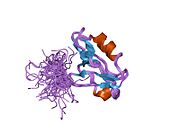Biology:PDLIM3
 Generic protein structure example |
Actin-associated LIM protein (ALP), also known as PDZ and LIM domain protein 3 is a protein that in humans is encoded by the PDLIM3 gene.[1][2][3] ALP is highly expressed in cardiac and skeletal muscle, where it localizes to Z-discs and intercalated discs. ALP functions to enhance the crosslinking of actin by alpha-actinin-2 and also appears to be essential for right ventricular chamber formation and contractile function.
Structure
ALP exists primarily as two alternatively spliced variants; a 39.2 kDa (364 amino acids) protein in skeletal muscle and a 34.3 kDa (316 amino acids) protein in cardiac muscle and smooth muscle.[4][5][6] ALP has a N-terminal PDZ domain and a C-terminal LIM domain. In addition, the ALP subfamily contains a specific 34 amino acid domain named the ALP-like motif, containing protein kinase C consensus sequences.[7] The PDZ domain of ALP binds to alpha actinin-2, specifically to its spectrin-like repeats.[8] The PDZ domain is a motif composed of 80-120 amino acids with conserved four residue GLGF sequences that typically interact with C-termini of cytoskeletal proteins.[9] The region of heterogeneity in the two isoforms is between the PDZ domain and LIM domain.[6] ALP is localized to chromosome 4q35.[8] It has been shown that deletion of muscleblind-like 1 in mice can alter the splicing pattern of PDLIM3.[10]
Function
Studies have shown that ALP is present at the first stage of myofibrilogenesis where it is bound to alpha actinin-2, and this association remains intact in mature myofibrils where ALP is localized to Z-discs and intercalated discs. Alpha actinin-2 is however not required for targeting ALP to Z-lines.[11] Studies in ALP knockout mice have shown that ALP facilitates the cross-linking of actin filaments by alpha actinin-2, and absence of ALP induces abnormal right ventricular chamber formation, dysplasia and cardiomyopathy.[12] Further studies using right ventricular epicardial systolic strain and geometric remodeling analysis in these animals unveiled that absence of ALP diminishes right ventricular contractile function and alters the pattern of cardiac hypertrophic remodeling.[13] Two studies using integrative genomic approaches to investigate genetic modifiers of collagen deposition[14] or intrinsic aerobic running capacity (ARC)[15] have mapped PDLIM3 to respective quantitative trait loci, suggesting that ALP may be involved in molecular networks related to these cardiac phenomena.
Clinical significance
Chromosome 4 pericentric inversion has been observed in 10 patients, with associated cardiac defects linked to terminal 4q35.1 deletions, which may affect PDLIM3.[16]
Interactions
ALP interacts with:
References
- ↑ "Exclusion of muscle specific actinin-associated LIM protein (ALP) gene from 4q35 facioscapulohumeral muscular dystrophy (FSHD) candidate genes". Neuromuscular Disorders 9 (1): 3–10. Jan 1999. doi:10.1016/S0960-8966(98)00087-X. PMID 10063829.
- ↑ "Novel gene transcripts preferentially expressed in human muscles revealed by quantitative hybridization of a high density cDNA array". Genome Research 6 (6): 492–503. Jun 1996. doi:10.1101/gr.6.6.492. PMID 8828038.
- ↑ "Entrez Gene: PDLIM3 PDZ and LIM domain 3". https://www.ncbi.nlm.nih.gov/sites/entrez?Db=gene&Cmd=ShowDetailView&TermToSearch=27295.
- ↑ "Protein sequence for human PDZ and LIM domain protein 3 (Uniprot: Q53GG5-2)". http://www.heartproteome.org/copa/ProteinInfo.aspx?QType=Protein%20ID&QValue=Q53GG5-2.
- ↑ "Protein sequence for human PDZ and LIM domain protein 3 (Uniprot: Q53GG5)". http://www.heartproteome.org/copa/ProteinInfo.aspx?QType=Protein%20ID&QValue=Q53GG5.
- ↑ 6.0 6.1 "Purification and characterization of an alpha-actinin-binding PDZ-LIM protein that is up-regulated during muscle differentiation". The Journal of Biological Chemistry 274 (41): 29242–50. Oct 1999. doi:10.1074/jbc.274.41.29242. PMID 10506181.
- ↑ "Insights into the molecular evolution of the PDZ/LIM family and identification of a novel conserved protein motif". PLOS ONE 2 (2): e189. 7 February 2007. doi:10.1371/journal.pone.0000189. PMID 17285143. Bibcode: 2007PLoSO...2..189T.
- ↑ 8.0 8.1 8.2 "Actinin-associated LIM protein: identification of a domain interaction between PDZ and spectrin-like repeat motifs". The Journal of Cell Biology 139 (2): 507–15. Oct 1997. doi:10.1083/jcb.139.2.507. PMID 9334352.
- ↑ "DHR domains in syntrophins, neuronal NO synthases and other intracellular proteins". Trends in Biochemical Sciences 20 (3): 102–3. Mar 1995. doi:10.1016/s0968-0004(00)88973-2. PMID 7535955.
- ↑ "Loss of muscleblind-like 1 results in cardiac pathology and persistence of embryonic splice isoforms". Scientific Reports 5: 9042. 12 March 2015. doi:10.1038/srep09042. PMID 25761764. Bibcode: 2015NatSR...5E9042D.
- ↑ "ALP and MLP distribution during myofibrillogenesis in cultured cardiomyocytes". Cell Motility and the Cytoskeleton 54 (3): 254–65. Mar 2003. doi:10.1002/cm.10102. PMID 12589684.
- ↑ 12.0 12.1 "Adult mice deficient in actinin-associated LIM-domain protein reveal a developmental pathway for right ventricular cardiomyopathy". Nature Medicine 7 (5): 591–7. May 2001. doi:10.1038/87920. PMID 11329061.
- ↑ "Deficiency of actinin-associated LIM protein alters regional right ventricular function and hypertrophic remodeling". Annals of Biomedical Engineering 33 (7): 888–96. Jul 2005. doi:10.1007/s10439-005-3604-y. PMID 16060528.
- ↑ "Integrative genomic approach identifies multiple genes involved in cardiac collagen deposition". Circulation: Cardiovascular Genetics 7 (6): 790–8. Dec 2014. doi:10.1161/CIRCGENETICS.114.000537. PMID 25217174.
- ↑ "Gene expression profiling of the left ventricles in a rat model of intrinsic aerobic running capacity". Physiological Genomics 23 (1): 62–71. Sep 2005. doi:10.1152/physiolgenomics.00251.2004. PMID 16033863.
- ↑ "Molecular cytogenetic characterization of a 4p15.1-pter duplication and a 4q35.1-qter deletion in a recombinant of chromosome 4 pericentric inversion". American Journal of Medical Genetics Part A 149A (2): 226–31. Feb 2009. doi:10.1002/ajmg.a.32603. PMID 19161154.
Further reading
- "Oligo-capping: a simple method to replace the cap structure of eukaryotic mRNAs with oligoribonucleotides". Gene 138 (1–2): 171–4. Jan 1994. doi:10.1016/0378-1119(94)90802-8. PMID 8125298.
- "Actinin-associated LIM protein: identification of a domain interaction between PDZ and spectrin-like repeat motifs". The Journal of Cell Biology 139 (2): 507–15. Oct 1997. doi:10.1083/jcb.139.2.507. PMID 9334352.
- "Construction and characterization of a full length-enriched and a 5'-end-enriched cDNA library". Gene 200 (1–2): 149–56. Oct 1997. doi:10.1016/S0378-1119(97)00411-3. PMID 9373149.
- "The ZASP-like motif in actinin-associated LIM protein is required for interaction with the alpha-actinin rod and for targeting to the muscle Z-line". The Journal of Biological Chemistry 279 (25): 26402–10. Jun 2004. doi:10.1074/jbc.M401871200. PMID 15084604.
´* "Ultrasonography for rheumatologists: the development of specific competency based educational outcomes". Annals of the Rheumatic Diseases 65 (5): 629–36. May 2006. doi:10.1136/ard.2005.039974. PMID 16192291.
- "Mutations in PDLIM3 and MYOZ1 encoding myocyte Z line proteins are infrequently found in idiopathic dilated cardiomyopathy". Molecular Genetics and Metabolism 90 (4): 435–40. Apr 2007. doi:10.1016/j.ymgme.2006.12.008. PMID 17254821.


